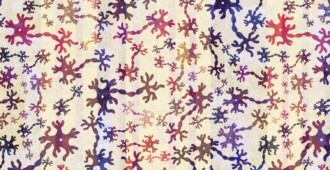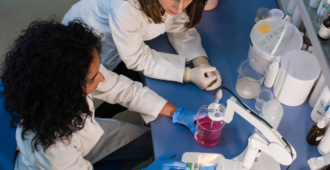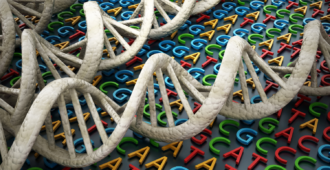In light of the upcoming Biomedical Research Advisory Panel meeting happening on Friday 7 April that will discuss which new research projects the MND Association will fund, we are pleased to report on the progress of one of our already-funded researchers. In their three year project, funded by the MND Association, Prof Annalisa Pastore (King’s College London) and Prof Gian Tartaglia (University Pompeu Fabra, Barcelona) are investigating the process by which TDP-43 binds to RNA. Below is a summary of the progress they made during their first year.
Background to the project

One of the causes of amyotrophic lateral sclerosis (ALS), the most common type of motor neurone disease (MND), is related to faulty functioning of the TDP-43 protein, a component that is naturally present in all of our cells. In healthy cells, TDP-43 resides in the centre of a cell (the nucleus) where it attaches to RNA and supports correct gene expression – that is, it helps to extract information carried by a gene to form proteins, the main building blocks of our bodies.
When the function of TDP-43 is affected, as is the case in ALS as well as in the associated frontotemporal dementia (FTD), it tends to transfer outside the nucleus where it abnormally accumulates and sticks together to form toxic ‘clumps’. The most ‘sticky’ regions of TDP-43 that enable its attachment to RNA are the same regions that makes the protein clump together. If we understand the exact process by which TDP-43 binds to RNA we can create compounds that could ‘block’ the sticky regions and therefore prevent toxic protein clumping.
Exploring TDP-43 aggregation properties
In order to design segments of RNA (ie aptamers) that the TDP-43 would stick to, the researchers first had to understand the properties by which the protein can attach to itself as well as to RNA. Specifically, they worked on identifying the locations on TDP-43 that are most likely to be sticky. They did so by using a computerised software that had already been successfully used to explore properties of toxic proteins in other neurodegenerative diseases (eg Alzheimer’s and Huntington’s disease).
Creating copies of TDP-43 and observing its toxic properties
Another step was to create extra copies of TDP-43 so that it could be used in further stages of the project. To do this, artificially-made compounds of TDP-43 (ie constructs) were produced and all constructs were then grown in an E. Coli bacterium cell and purified to discard unnecessary parts of the protein. Three constructs were then selected for final analyses; RRM1, RRM2 and RRMs.
Designing and testing RNA aptamers
After working out the location of the sticky sections of TDP-43, the team then designed three aptamers that copy the RNA-binding properties of TDP-43 and that were predicted to bind well with the protein; these aptamers are called Apt1, Apt2 and Apt3. Multiple interactions between all the constructs and aptamers were then observed to find out which pair binds together the most and to confirm the regions of TDP-43 that are most prone to clumping.
Of the three final constructs created in Step 2, RRMs was found to bind best with all the aptamers. Additionally, all three constructs were found to have the ability to form toxic clumps. This is important so that the TDP-43 constructs can be observed for whether the accumulation of proteins slows down or stops after the introduction of aptamers.
What happens next?
The researchers will now replicate all interactions with a second set of aptamers that are slightly different in structure. Once the aptamers with the best binding abilities are selected, their ability to slow down the progression of clump formation will be examined again. The structure and quantity of the aptamer-treated constructs will also be compared to TDP-43 clumps that naturally occur in motor neurones of people in MND and FTD.
As all of the previous testing was not carried out within a cell, the interactions will now be replicated in human neuronal cells grown in a laboratory dish and observed for the formation of clumps under the influence of aptamers.
Looking more into the future, knowing the specific aptamers that have the ability to bind to the sticky regions of TDP-43 and therefore prevent them from clumping together could be used as a foundation for a new treatment therapy against ALS and FTD.






Good luck keep up the good work
So interesting this site. Learn so much.